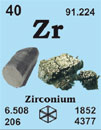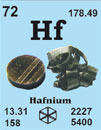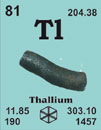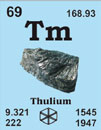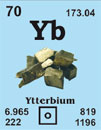Yttrium 39Y88.905
Discovered in 1794 by J. Gadolin at Åbo, Finland.
[Named after Ytterby, Sweden]
French: yttrium
German: Yttrium
Italian: ittrio
Spanish: ytrio
Description: Yttrium is a soft, silvery-white metal that is stable in air due to the formation of an oxide film on its surface. It burns if ignited, and is attacked by water and forms hydrogen. Yttrium is used in various ways: to give red colours in TV screens, in X-ray filters, superconductors and for superalloys.
Yttrium single crystal properties
| State: |
single crystal |
|---|
| Crystal structure: |
hexagonal |
|---|
| Production method: |
Floating zone |
|---|
| Standard size: |
diameter 4mm
thickness 1mm |
|---|
| Orientation: |
(0001) |
|---|
| Orientation accuracy: |
<2°, <1°, <0.4° or <0.1° |
|---|
| Polishing: |
as cut, one or two sides polished |
|---|
| Roughness of surface: |
<0.03µm |
|---|
| Purity: |
99.95% |
|---|
| Typical analysis (ppm): |
C 3
H < 1
O 9
N < 5
Cu 1.60
Fe 1.80
Ni < 1
Pb 0.30
Si 0.30
Ga, Hf and Ta are below the detection limit
|
|---|
Materials properties
| Density: |
4.47 g/cm3 |
|---|
| Melting point: |
1521.85 °C / 1795 °K |
|---|
| Boiling point: |
3337.85 °C / 3611 °K |
|---|
| Molar volume: |
19.89 cm3 |
|---|
| Thermal conductivity: |
17.2 [300 K] Wm-1K-1 |
|---|
| Coefficient of linear thermal expansion: |
10.6 x 10-6 K-1 |
|---|
| Electrical resistivity: |
57.0x 10-8 [298 K] Wm |
|---|
| Mass magnetic susceptibility: |
+2.70 x 10-8(s) kg-1m3 |
|---|
| Young's modulus: |
66.3 GPa |
|---|
| Rigidity modulus: |
25.5 GPa |
|---|
| Bulk modulus: |
n.a. GPa |
|---|
| Poisson's ratio: |
0.265 |
|---|
| Radii: |
Y3+ 106; atomic 181; covalent 162 |
|---|
| Electronegativity: |
1.22 (Pauling); 1.11 (Allred); 3.19 eV (absolute) |
|---|
| Effective nuclear charge: |
3.00 (Slater); 6.26 (Clementi); 8.72 (Froese-Fischer) |
|---|
| Number of Isotopes (incl. nuclear isomers): |
32 |
|---|
| Issotope mass range: |
80 -> 99 |
|---|
| Crystal structure, (cell dimentions / pm), space group |
hexagonal |
|---|
| X-ray diffraction: mass absorption coefficients: |
CuKα 134 (µ/r) / cm2g-1
MoKα 100 (µ/r) / cm2g-1 |
|---|
| Neutron scattering length: |
0.775 b/10-12 cm |
|---|
| Thermal neutron capture cross-section: |
1.28 sa / barns |
|---|
Biological data
| Biological role: |
none |
|---|
| Toxicity |
|
|---|
| Toxic intake: |
n.a. |
|---|
| Lethal intake: |
c. 15 g only one case reported) |
|---|
| Hazards: |
Bismuth is regarded as one of the less toxic heavy metals and it is commonly used as a medicine for stomach upsets. Excess bismuth can cause mild kidney damage |
|---|
| Level in humans |
|
|---|
| Blood: |
0.016 mg dm-3 |
|---|
| Bone: |
<0.2 p.p.m. |
|---|
| Liver: |
0.015 - 0.33 p.p.m. |
|---|
| Muscle: |
0.32 p.p.m. |
|---|
| Daily dietary intake: |
0.005 - 0.02 mg |
|---|
| Total mass of element in average [70 kg] person: |
< 0.5 mg |
|---|
Geological data
| Mineral | Formula | Density | Hardness | Crystal apperance |
|---|
| Bastnäsite-Y |
(Y, Ce)Co3F |
4.0 |
4 - 4.5 |
tri. translucent brick-red |
|---|
| Fergusonite |
YNbO4 |
5.7 |
5.5 - 6.5 |
tet., vitreous, sub-metallic black |
|---|
| Gadolinite |
Be2FeY2Si2O10 |
4.4 |
6.5 - 7 |
mon., vit./greasy greenish-black |
|---|
| Polycrase-Y |
Y(Ti, Nb)2(O, OH)6 |
5.0 |
5.5 - 6 |
orth., sub-metallic black |
|---|
| Samarskite |
AlO(OH) |
3.3 - 3.5 |
6.5 - 7 |
orth., vit./resinous |
|---|
| Xenotime/TD> |
YPO4 |
4.8 |
4 - 5 |
tet., vit./resinous yellow-brown |
|---|
| Chief ore: |
xenotime, bastnäsite, fergusonite, samarskite |
|---|
| World production: |
400 tonnes/year |
|---|
| Main mining areas: |
xenitine in USA, bastnäsite in Russia, fergusonite in Norway, Russia, Madagascar |
|---|
| Reserves: |
c. 9 x 106 tonnes |
|---|
| Specimen: |
available as chieps, ingots or powder. Safe. |
|---|
| Abundances |
|
|---|
| Sun: |
125 (relative to H = 1 x 1012) |
|---|
| Earth's crust: |
30 p.p.m. |
|---|
| Seawater: |
|
|---|
| Residence time: |
|
|---|
| Classification: |
|
|---|
| Oxidation state: |
III |
|---|
Source: Emsley, J. (1998) The Elements (3rd Edition)

 English
English
 Deutsch
Deutsch








































